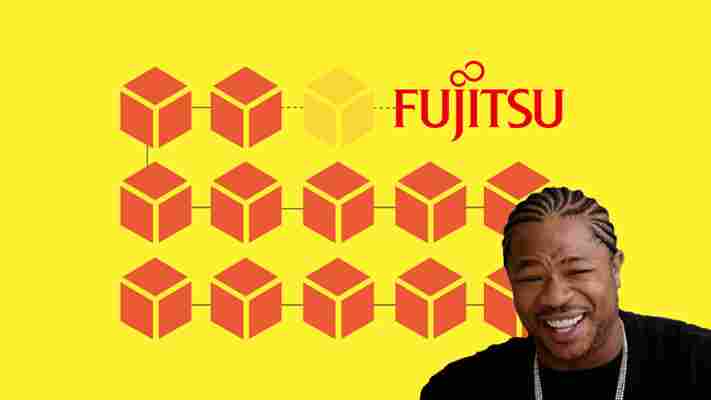Fujitsu built a blockchain that blockchainifies other blockchains
Yesterday, Japanese IT major Fujitsu announced its new ConnectionChain payments technology aimed at facilitating transactions between b lockchains.

The payments system intends to provide a means for different cryptocurrency networks to interoperate with each other.
In a statement , the company said that there is an increasing number of activities around digital currency exchanges and initial coin offerings (ICO).
“Settlement between virtual currencies managed using Blockchains [sic], however, requires a reliable application to handle the currency exchange processing at the boundaries between the Blockchains [sic], and ensuring transparency in this process has been an ongoing issue,” the company said in the announcement.
According to the Fujitsu, the payments technology can resolve the issues surrounding such transactions by inter-connecting multiple blockchains and executing a single transaction process that can be automated.
Part of Fujitsu’s description of its new product reads:
Fujitsu also revealed that it plans to commercialize the technology starting 2018. However, the company claimed that this will depend on the results of additional testing and development of the product:
Fujitsu is one of the many companies looking to explore the commercial applications of blockchain technology. Earlier this year, the Japanese tech giant partnered up with banking associations to explore how blockchain can be used in the banking system.
This post was originally published by The Cointelegraph . Check out their excellent coverage and follow them down here:
This cryptocurrency exchange was actually a $384 million Ponzi scheme
The CEO of South Korean cryptocurrency “exchange” CoinUp has been sentenced to 16 years prison for his role in defrauding investors out of 450 billion won ($384 million), Yonhap News reports.

Mr. Kang-mo, alongside a raft of his executives, were found to have deceived thousands of CoinUp customers by promising returns of up to 200 percent on cryptocurrency investments, just 4-to-10 weeks after purchase.
A judge also sentenced the firm’s chief financial officers, Mr. Kwon and Mr. Shinmo, to 11 years in prison. CoinUp’s “governor” Mr. Yunmo was given 7 years imprisonment, alongside his mother-in-law.
Several other executives were reportedly sentenced to between six and nine years in prison.
CoinUp promised crypto prices would increase after listing
The investments CoinUp execs shilled had little-to-no chance of increasing in value. Local outlet TVCC reported that CoinUp execs would convince their victims to invest by promising to list the coins in the near future.
Even more curious, investigators found that Kang-mo had displayed a fake magazine in CoinUp offices that showed him standing alongside South Korean president Moon Jae-in, presumably in a bid to mislead potential investors.


The Seoul Central District Court noted CoinUp operated as a multi-level organization that ensured those who invested early were rewarded directly with the profits generated by those who invested later — which bears the hallmarks of a classic pyramid scheme.
Earlier this year, South Korean police employed a special “artificial intelligence investigator” to identify investment scams, leading them to arrest the masterminds of a $19 million Bitcoin-fueled Ponzi scheme.
Ripple CEO: Bitcoin’s influence over cryptocurrency prices is almost over
Since their inception, altcoin prices have mostly risen and fallen with the price of Bitcoin. According to Ripple CEO Brad Garlinghouse, those days are numbered.

“There’s a very high correlation between the price of [Ripple] and the price of bitcoin, but ultimately these are independent open-sourced technologies,” Garlinghouse told CNBC . “It’s early, over time you’ll see a more rational market and behaviors that reflect that.”
In the earliest days of altcoins, it was a necessary evil.
Entering a cryptocurrency market was typically accomplished in a fairly straightforward manner: purchase Bitcoin (BTC) by trading your preferred currency (like USD) for an equivalent number of coins (based on current market value) through a credit card transaction or ACH payment.
Most transactions ended there. Investors purchased cryptocurrency and held it on sites like Coinbase in hopes it would appreciate in value.
But then additional coins started entering the market. It started slowly and then crescendoed in recent years as awareness of cryptocurrency markets — and their success stories — began to grow. Now there are more than 1,500 smaller coin projects, or altcoins, with more entering the market each passing month.
Investors started to take interest in these projects, mostly because they could purchase them for pennies in hopes they’d reach Bitcoin-like price levels later on. It was another chance to get in early on the next big cryptocurrency project, something many thought they’d missed after Bitcoin began trading in the thousands of dollars.
Where one Bitcoin might cost you several thousand dollars, you could purchase coins like XRP for just a few cents. Owning one coin is never quite as sexy as owning thousands.
Now, rather than buying to hold, investors were interested in using Bitcoin to purchase an early entry into these smaller projects. Unfortunately, you couldn’t trade fiat currency for altcoins like you could with Bitcoin. Investors had to move BTC from a wallet, like Coinbase, to a marketplace, like Poloniex or Binance, where they were then traded for altcoins. Once traded, the altcoin no longer had a fiat currency value. Instead, it was measured against the currency used to purchase it. XRP, for example, was now valued in BTC, not USD.
When trading in pairs, you’re making two transactions with each trade: buying one currency, and selling another. Buying XRP, for example, involved selling BTC, and then hoping it appreciated at a faster rate than the currency it was traded against (BTC).
For altcoins, this is problematic for a number of reasons. Most important is probably the correlation with BTC price on its underlying value. If BTC tumbles 20 percent, for example, there’s a good chance its trading pair will depreciate in value as well.
For what it’s worth, I believe Garinghouse is correct, but it’ll take direct-to-fiat trading pairs to make it happen. Once investors can purchase XRP, for example, and trade it against USD, its value will no longer be tied to BTC and its wild price swings. That won’t stop volatility, but it will ensure that rapid price swings are caused by activity related to XRP or the cryptocurrency market as a whole, and not just Bitcoin.
We’re seeing the beginnings of this already. Bittrex, a popular trading marketplace, recently added USD pairs. Binance has similar plans in the works.

Leave a Comment